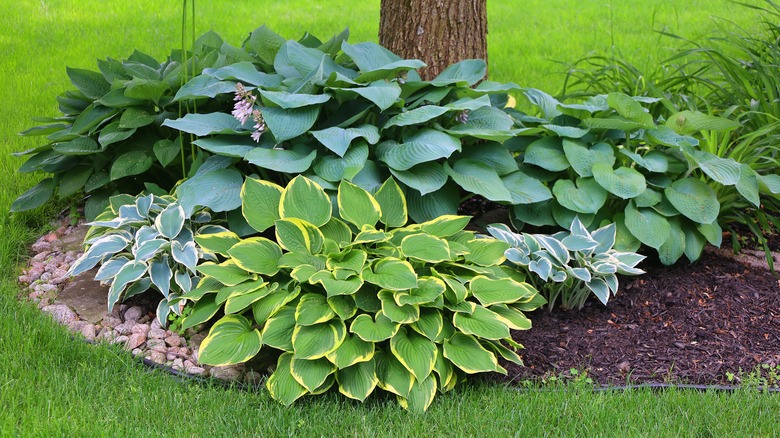That Common Hosta Mistake Behind Faded, Weak Leaves
Known for their elegantly textured leaves, shade-loving hostas (Hostaceae) are a go-to plant for many home gardeners. These flowering, non-native perennials are suitable for USDA Hardiness Zones 3 through 9 and can add fullness to any garden, even ones that get very little sunlight. However, there is one common mistake with hostas that can make the difference between a thriving, highly pigmented plant and one that's struggling to function — namely, placing them too close to bright lights in your patio or backyard. (Bet you didn't think of that!)
Hostas fare best in moist, shaded areas and can weaken or fade with prolonged exposure to harsh, heat-emitting lights. Over time, these conditions can also create a breeding ground for pests like slugs and snails, which are known to afflict this plant and bite unsightly holes into those gorgeous leaves. Yes, some backyard lighting might be essential to brighten your garden and keep it easy to navigate after the sun has gone down, but you'll want to position your hostas out of the lights' vicinity. That way, their leaves won't get scorched by the lightbulbs, and they'll stay strong enough to ward off pests.
Where to plant your hostas instead, and how to care for them
Hostas favor damp soil and minimal light, though they enjoy morning sun. Instead of planting them near patio lighting, try placing your hostas in a shady spot under a tree and far away from any major light source (natural or artificial). You can also plant them in well-drained containers or pair them with other low-light plants to grow a flourishing shade garden. In these conditions, they'll grow wide and strong and may flower. Be sure to keep the soil moist yet not soaking wet, especially if you live in an area that's experiencing very little rain — hostas do need a fair amount of moisture to thrive.
Since hostas are cold-resistant, you'll notice those sprawling green leaves maintaining their integrity well into fall. If their leaves fade with the drop in temperature, that's a sign that your hostas are entering their dormant season. At that point, it's best to trim them to prevent the leaves from getting mushy and attracting moisture-loving pests. You can cut them back fully for winter and look forward to more blooms next spring. Hostas will generally continue growing in the same place year after year with little interference on your part.
Other plants that won't fare well near backyard lights
Hostas aren't the only plant that's susceptible to wilting under the intensity of harsh patio lighting. Other popular perennials, like gardenias (Gardenia jasminoides) or bleeding heart flowers (Lamprocapnos spectabilis), should also be planted far away from any bright, hot bulbs in your backyard or garden. Both plants rely heavily on natural fluctuations in temperature and light over the course of each day to thrive. Artificial lightning can mess with those cues and arrest their growth, not to mention burn their delicate leaves and attractive flowers. The same logic applies to many flowers that open at night, such as evening primrose (Oenothera biennis). If you're a fan of primrose's dainty yellow blooms and want to plant them somewhere they'll flourish, space them out so they aren't coming into contact with patio lights after dark.
If you're looking for a dense, hosta-like perennial that's less sensitive to light, coral bells (Heuchera americana) are one possible alternative. These native perennials grow well in a range of light conditions — think full sun to shade — so they can handle being planted closer to an artificial light source. They're low-maintenance, come in virtually any color you can think of, and can even attract hummingbirds and butterflies to your yard.


